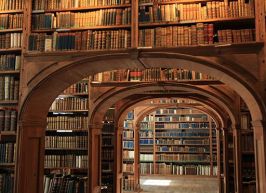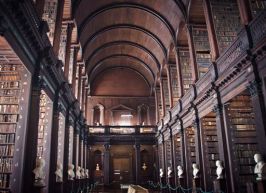
A Portrait of the Artist as a Young Man
- Novel
- Modernism
What It’s About
The Desire for Great Art
Many an author has written about their coming of age, but there is hardly anyone who approached this task as uncompromisingly as James Joyce in A Portrait of the Artist as a Young Man. Joyce follows the development of his alter ego with painstaking precision, from the state of naive childhood to self-confident and independent artist. It is no accident that the main character’s name, Dedalus, is reminiscent of the Dedalus of Greek mythology, who escapes from prison with his self-made wings – though for Stephen, freedom from the confines of his Irish upbringing comes through visits to brothels, philosophical debates and solitary walks along the beach. Joyce’s debut novel foreshadows what was to follow in its wake: stylistically and intellectually demanding literature that would define the era of Modernism. With A Portrait of the Artist as a Young Man, Joyce created a masterpiece: high art that still is full of life.
Summary
About the Author
James Joyce was born in Dublin on February 2, 1882, into a middle-class Catholic family, the eldest of ten children to survive infancy. He attended the Jesuit boarding school Clongowes Wood but had to leave in 1892 because his father could no longer afford the fees. He studied at home for some time, and then took a place at Belvedere College. In 1898, he went to study English, French and Italian at the newly established University College Dublin, where he joined various theatrical and literary circles. He started writing reviews and short articles as well as two plays, which have since been lost. His anti-Catholic attitude is apparent throughout his work and led to severe criticism from the conservative side. After graduating, he went to Paris to study medicine but soon abandoned his program. When his mother was diagnosed with cancer in 1902, he returned to Ireland. His mother died in the summer, and Joyce started to drink heavily and just managed to make a living by reviewing books, teaching and singing. In 1904, he met Nora Barnacle, and the couple moved to Trieste, where Joyce taught English. In 1906, their first child, George, was born, followed two years later by Lucia. In 1914, Joyce’s collection of short stories, Dubliner was published. One year later, Joyce moved to Zurich, where he first came into contact with Dadaism and Expressionism. In 1916, he published his first novel, A Portrait of the Artist as a Young Man, which established him as a serious writer. However, it wasn’t until the publication of Ulysses in 1922 that Joyce reached true literary fame. In the 1920s, Joyce moved with his family to Paris and, in 1939, published Finnegans Wake, his most surrealist work. When Nazi Germany invaded Paris, Joyce fled to Zurich. He suffered from a perforated duodenal ulcer, for which he had to undergo surgery. He fell into a coma shortly after the surgery and died on January 13, 1941, aged just 58.




Comment on this summary